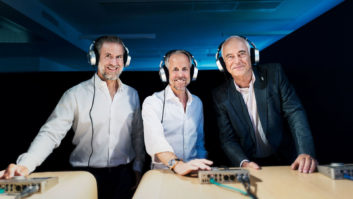2,000-WATT STEREO POWER AMPLIFIERTsunami Technologies’ first foray into the pro audio world was at this year’s Winter NAMM in Los Angeles, where the San Francisco-based company unveiled its range of compact mixers, crossover/EQ products and amplifiers. Though most of the company’s products-such as its powered mixers and P.A. heads-are designed for the MI market, I was interested in checking out its top-of-the-line HQS series of power amplifiers: two-rackspace professional models offering as much as 980 watts per channel (into a 4-ohm load).
All models in the HQS series are dual-channel units, including the 300-watt HQ702S ($695), the 400-watt HQ902S ($895), the 600-watt HQ1302S ($995) and the 980-watt/side flagship HQ2002S ($1,195), which delivers 2,000 watts in bridged mono mode. Incorporating switch mode power supplies, the HQS amps are quite light compared to amps having conventional linear supplies, with the high-end HQ2002S weighing in at just less than 28 pounds. The output stage uses a Class-H design. Other standard features of the HQS amps are thermally controlled variable-speed cooling (via dual rear fans), stereo and bridged mono operation, onboard overload limiter, bandwidth extending beyond 50 kHz, and protection circuits to guard against dead shorts, overvoltage and DC voltage conditions.
The front panel has a single power switch, detented 21-step input attenuator controls and LEDs to indicate signal presence, power on/off, channel peaks and protection circuit activity. The rear panel contains the attached AC cord (for 120VAC/60Hz operation), Neutrik Combo jack 11/44-inch/XLR (pin 2 hot) inputs, a set of female XLRs line outs wired in parallel to the inputs for chaining inputs to another amp, a dual-channel/bridged switch, dual fan airflow outs, and both five-way binding posts and Neutrik Speakon output jacks. Another nice touch is the rear rack rails, essential even on a “lightweight” 28-pound amp, which also offer some protection for the rear connectors.
Hookup/setup is straightforward. The Combo input connectors handle either balanced or unbalanced sources, although the bridge/dual channel switch is placed just under the input XLRs and would be easy to bump into the wrong position if someone was reaching behind a rack to make a hookup connection. A bit of duct tape solved the problem, but a recessed or lockable switch would be preferable. The binding posts seemed to be lower quality than the rest of the amp, although most users of this amp will probably use the Speakons.
After making sure all connections were tight, I powered up the amp and was pleased by its slight power-up delay with “thump-less” startup. The 21-step input attenuators were nice and offer repeatable settings, but are unnecessary in most pro applications. I began using the HQ2002S in 2-channel mode to drive four 8-ohm stage wedges and the amp handled this 4-ohm/side load with no sweat. The audio was very clean with plenty of power and even after hours of driving the system, the chassis stayed fairly cool and its (low-noise) fans never needed to kick in to high speed. After the gig, I made a few tests, intentionally overdriving the inputs to check out the onboard limiter. Here, the limiter action was clearly audible when critically listening to the system, but it’s certainly much better than having to worry about (or hear) clipping.
On another outing, the HQ2002S was used to drive two dual-15-bass bins in parallel on each channel (2 ohms/side), and I definitely got the cooling fan up to speed on this date, although the amp stayed cool, never complained and pumped out tight bass all night. And thanks to an intermittent bad cable discovered during setup, I got to check out the amp’s short-protection feature, which mutes the amp when the output is shorted. Once the short condition is removed, the amp must be powered down/up to restore, as there is no auto-reset feature.
Overall, the amp is well-built, sounds great and is priced right. Based on my experiences with the HQ2002S, I’d say that Tsunami is off to a good start.
Tsunami Technologies, 459 Geary St., San Francisco, CA 94102; 415/776-9705; fax 415/776-9214; www.tsunamitechnologies.com.







